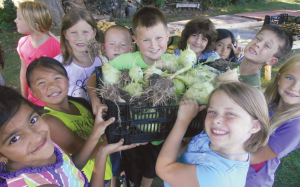Creating School Gardens that Last

Originally appears in the Spring 2014 issue
SIX YEARS BEFORE the Tomorrow River School District garden existed in greens and yellows and oranges, it existed in black and white. In 2006, a dedicated group of parents and teachers from the district—centered in Amherst, Wisconsin—drafted a school wellness policy identifying gardens as a strategy for implementing a comprehensive nutrition education program. The policy also included specific plans for installing the school garden within the school grounds master plan. Six years later, the district’s garden came to life.
This fall, Mrs. Doll’s first grade class could be found tiptoeing through a field of vines, hunting for pumpkins and winter squash. Accompanying the children was the district’s food service director—the pumpkin harvest was bountiful enough to cook and serve for lunch at Amherst’s K-12 school. The wellness policy also lays out space for fruit trees, and the school district is hoping to raise funds to hire a garden coordinator.
This tableaux may sound like an educator’s ultimate green fantasy, but it became a reality largely due to Amherst’s use of a wellness policy. Too often, school gardens are abandoned due to changes in staff, reduced funding, or shifting educational trends. Having a wellness policy to support the sustainability of a garden program not only increases the garden’s longevity, but helps set goals to monitor its progress.
This content is restricted to subscribers only.
If you are not yet a subscriber, please consider taking out a subscription here.
If you are an existing subscriber, kindly log in or contact us at info@greenteacher.com for more information.





